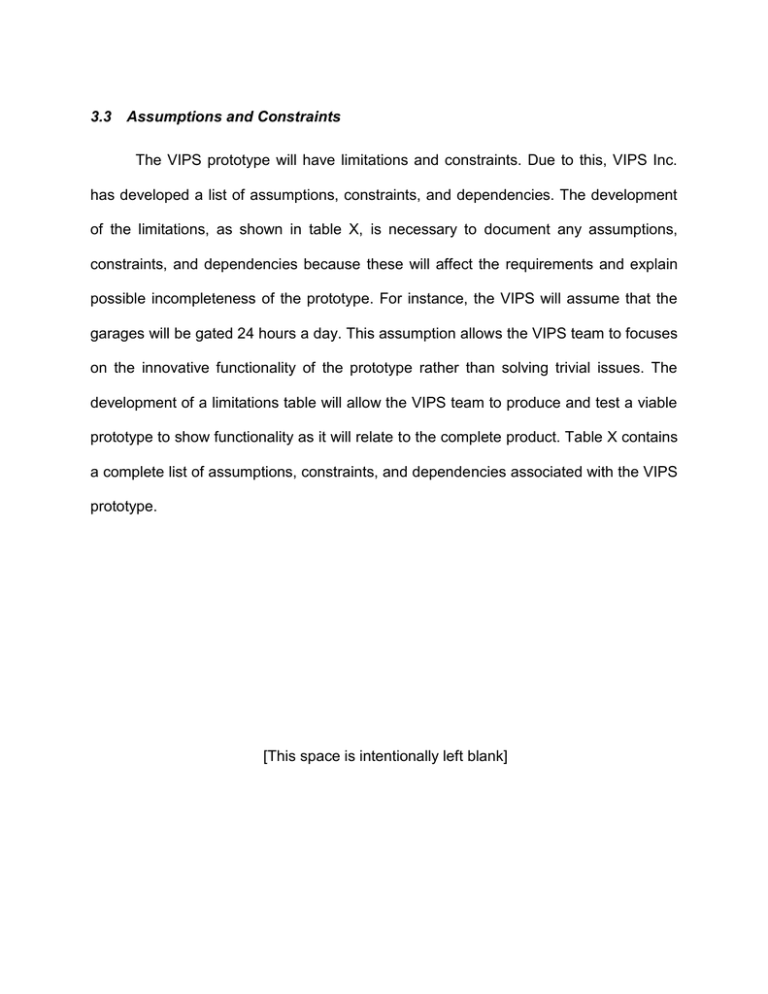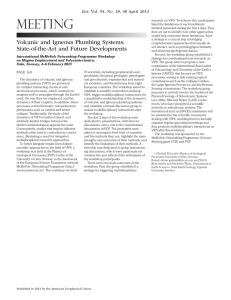3.3 Assumptions and Constraints
advertisement

3.3 Assumptions and Constraints The VIPS prototype will have limitations and constraints. Due to this, VIPS Inc. has developed a list of assumptions, constraints, and dependencies. The development of the limitations, as shown in table X, is necessary to document any assumptions, constraints, and dependencies because these will affect the requirements and explain possible incompleteness of the prototype. For instance, the VIPS will assume that the garages will be gated 24 hours a day. This assumption allows the VIPS team to focuses on the innovative functionality of the prototype rather than solving trivial issues. The development of a limitations table will allow the VIPS team to produce and test a viable prototype to show functionality as it will relate to the complete product. Table X contains a complete list of assumptions, constraints, and dependencies associated with the VIPS prototype. [This space is intentionally left blank] Conditions Type Effect on Requirements The parking environment will be gated 24 hours Assumption Eliminate the need of tracking cars when gates are open Prototype will only service visitor requests one at a time A computer will be in parking services to facilitate last minute requests A table in the database will be used for the blacklist User passwords will be plain text There will be enough spaces in the garage at the start of the day to allocate visitor spaces Only one car at a time will pass through the entrance or exit A CS department laptop is available to run the application. The VIPS engine is used to process garage traffic The VIPS website is used to process visitor requests Assumption Assumption Assumption Assumption Assumption Assumption This allows for the simulation to process the barcode/RFID reads one at a time Dependency If it is not, a student laptop will be used Dependency The database of the prototype will fail if the VIPS engine does not work. Dependency The database of the prototype will fail if the VIPS website does not work. Cars can only have one RFID Constraint tag at a time Cars will not be able to take up more than one space Prototype will not deal with mass subscriptions Will allow the system to use the same services for advance and day of purchases A customer based database will not be created. The customer database will be emulated as a table in the VIPS database. Prototype will not enforce an encryption algorithm on the user passwords Allows the visitor parking to be guaranteed without the reallocating of subscription spaces, prior to the visitor capacity of the garage. Constraint Eliminates the collusion of two tags attempting to access the reader at the same time. Limits the problem of cars taking up more than one space. Allows the prototype to maintain an accurate garage count. Table X. Assumptions, Dependencies, and Constraints on Prototype Requirements 3.4 Non-Functional Requirements Non-functional requirements characterize the performance of the prototype. They are elements that are present in the all aspects of the development of the prototype. The non-functional requirements do not impact the innovative features of the prototype but are needed for successful development. The non-functional requirements are security, maintainability, and reliability. 3.4.1 Security Security is very critical for the VIPS prototype. VIPS customers must be ensured that their data will not be compromised. VIPS will ensure security through the use of access control. Access control is critical to make sure that the system will not be abused. Access control will be implemented through the use of username/password. The Access control will be created according to functional requirement 3.1.X, it will not allow unauthorized users access to the system and grant authorized users the appropriate access. Security is of the upmost importance to VIPS Inc and the appropriate measures will be taken to ensure data security. 3.4.2 Maintainability The two main things that need to be maintained are the VIPS software systems and the garage hardware. Once visitor are added to the system, their information is stored internally in the prototype database. The information is stored to allow the visitor access on the day they have registered for. The visitor data will also be maintained for future visits and to help develop historical trends. The website must be maintained in order to allow the visitor to register. The VIPS engine must also be maintained to ensure the garage will allow authorized users to enter and exit the garages. Hardware, including laptop and the barcode scanner will be inspected by the VIPS team. This inspection will include a visual check as well as operational tests. It is very important for the VIPS team to maintain all software components to include, VIPS database, VIPS engine, and VIPS website and hardware to ensure an effective prototype development and demonstration. 3.4.3 Reliability In order for the VIPS prototype to be successful, it must meet a level of reliability. The barcode reader must be able to scan passes with at least 95% reliability, from a maximum distance of 6 inches. The prototype software must also work correctly with no critical errors and be able to appropriately interface with all other components. The VIPS engine should be free of any conditions that could cause the software to freeze. The databases will be able to be accessed to store and query data whenever necessary, with little to no lag time. The VIPS website must be able to handle multiple access requests and handle them without degradation of the system. The website must also be able to route visitor requests to the database. Reliability is a very important aspect to ensure a successful development of the VIPS prototype.
